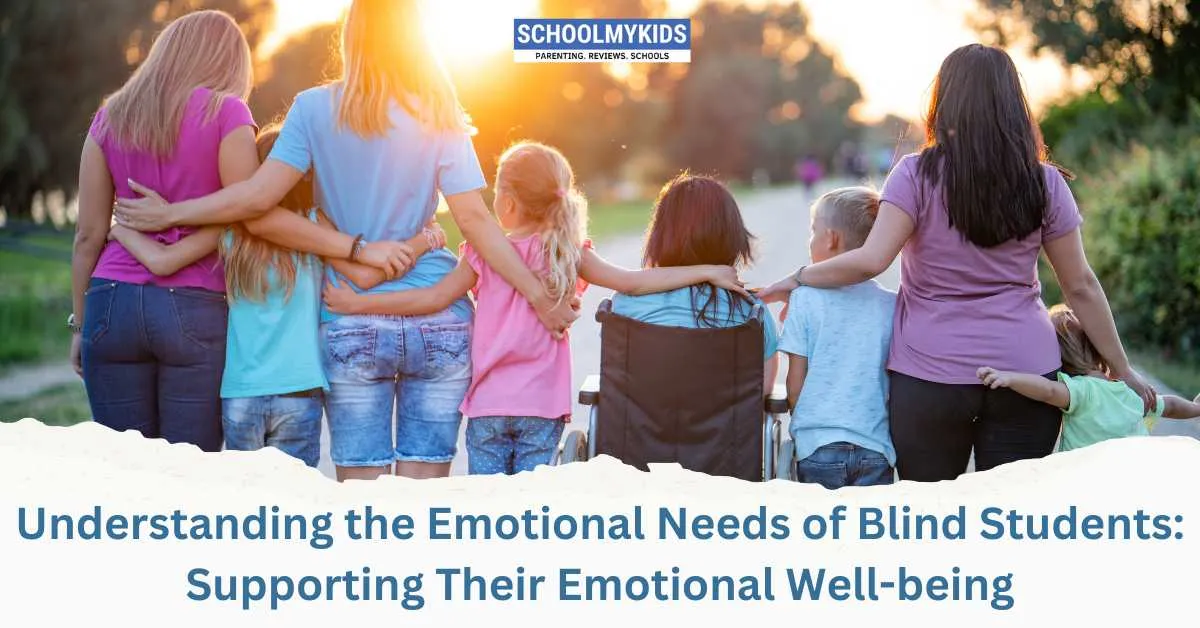The emotional well-being of blind students is a critical aspect of their overall development, yet it is often overshadowed by their physical and academic needs. Blind students face unique challenges that can significantly impact their emotional health. While visual impairments do not inherently affect cognitive abilities, the emotional challenges that come with blindness can influence their self-esteem, social interactions, and ability to engage with peers. Understanding these emotional needs and providing the necessary support is essential to ensure that blind students can thrive both emotionally and academically.
The Emotional Impact of Blindness
Blindness or severe visual impairment can shape a child’s emotional development in many ways. While each child is different, common emotional challenges often include feelings of isolation, anxiety, frustration, and low self-esteem. These challenges can affect their ability to engage with peers, participate in activities, and navigate everyday life.
- Isolation and Social Integration: Blind students may struggle with social integration, especially in a world that is largely visual. Social isolation can result from the difficulty of engaging with peers in group settings, playing in sports, or participating in visually-based activities. Without the ability to access visual cues such as facial expressions or body language, blind students may find it harder to develop social connections, which can lead to loneliness and feelings of alienation.
- Frustration and Dependency: A lack of independence or feeling reliant on others for everyday tasks can lead to frustration. For example, blind students may experience anxiety around mobility or completing tasks on their own, especially in unfamiliar environments. They might also feel frustrated if their peers or teachers underestimate their abilities, which can impact their emotional confidence.
- Low Self-Esteem: Blindness can sometimes lead to internalized feelings of inferiority, particularly if children feel that they are not as capable as their sighted peers. Negative stereotypes about blindness, combined with societal attitudes or misconceptions, can contribute to a diminished sense of self-worth. These feelings can affect academic performance, social relationships, and overall well-being.
- Anxiety and Fear of the Unknown: Fear and anxiety are common emotional challenges for blind students. Whether it is the fear of navigating unfamiliar spaces, uncertainty in completing tasks without assistance, or concern over how others perceive them, blind students may experience significant anxiety. They may also feel a heightened sense of vulnerability, especially in new or crowded environments.
Supporting the Emotional Well-being of Blind Students
Given the emotional challenges that blind students face, it is essential to provide appropriate support to help them navigate their educational experiences. Teachers, caregivers, and peers can work together to create an environment where blind students feel accepted, valued, and capable. Below are several strategies to foster emotional well-being for blind students.
1. Encouraging Inclusivity and Acceptance
One of the most important ways to support blind students emotionally is by fostering an inclusive classroom culture. When students feel accepted and part of the group, their emotional well-being improves, and they are more likely to develop healthy self-esteem.
- Promote Awareness: Educate sighted students about blindness and other disabilities. This helps to demystify blindness and promote empathy, reducing the likelihood of bullying or social exclusion.
- Model Positive Behavior: Teachers and caregivers should model inclusive behaviors, such as encouraging sighted students to assist blind peers when necessary, while also allowing blind students to complete tasks independently.
- Encourage Peer Relationships: Facilitate social opportunities for blind students by organizing group activities, cooperative learning projects, or collaborative discussions. Encourage sighted peers to participate actively and support blind students, fostering a sense of belonging.
2. Providing Emotional Support
Blind students may feel a range of emotions, from frustration to self-doubt, and providing emotional support is essential to their well-being. Teachers and caregivers should create an environment where students feel comfortable expressing their feelings.
- Active Listening: Give blind students the space to express themselves. Active listening, where you validate their feelings and acknowledge their experiences, is a crucial first step in offering emotional support.
- Encouraging Open Dialogue: Establish a relationship of trust where blind students feel comfortable sharing their challenges and frustrations. Address their concerns empathetically and provide reassurance when needed.
- Positive Reinforcement: Celebrate their efforts and achievements. Acknowledge progress, even small steps, which helps to build their self-esteem and motivation.
3. Building Independence and Self-Confidence
One of the key ways to improve the emotional well-being of blind students is to help them develop independence. When students feel capable of handling tasks on their own, it fosters a sense of empowerment and self-worth.
- Promote Self-Advocacy: Teach blind students to speak up for their needs, whether it's requesting accommodations or asking for help when necessary. This helps them develop a sense of autonomy and control over their educational experience.
- Encourage Problem-Solving: Blind students should be given opportunities to solve problems independently. Teachers can guide them through the process, allowing them to experience the satisfaction of overcoming challenges.
- Support Mobility and Orientation: Provide opportunities for blind students to learn mobility skills, such as using a white cane or navigating new environments. Gaining confidence in these skills will reduce feelings of dependence and enhance self-reliance.
4. Fostering Social Connections
Building social relationships is essential for all children, and blind students are no exception. Teachers can play a pivotal role in creating opportunities for blind students to interact with peers and form meaningful friendships.
- Group Work and Collaboration: Encourage group activities that require interaction, teamwork, and collaboration. These settings can help blind students build connections with peers while also developing social skills.
- Buddy Systems: Implement buddy systems in which sighted students are paired with blind students for support during classroom activities, field trips, or lunchtime. This ensures that blind students are included and can form bonds with their peers.
- Extracurricular Activities: Support blind students in participating in extracurricular activities, such as music, drama, or sports, where they can interact with peers in non-academic settings. Ensure that these activities are accessible and inclusive.
5. Creating a Safe and Supportive Environment
A safe and supportive environment is key to helping blind students feel emotionally secure. Teachers and caregivers should make sure that blind students feel welcomed and understood at all times.
- Adapt the Learning Environment: Ensure that classroom layouts, materials, and teaching methods are adapted to meet the needs of blind students. This may involve using Braille materials, tactile learning tools, and assistive technology to make lessons more accessible.
- Respect Privacy and Autonomy: While offering support, it is essential to balance it with respect for the blind student’s privacy and autonomy. Encourage students to seek help when needed, but also allow them to complete tasks independently as much as possible.
- Monitor for Bullying or Exclusion: Teachers must be vigilant about preventing bullying or exclusion based on the student's blindness. If bullying is suspected, address it immediately to prevent lasting emotional damage.
6. Promoting Emotional Resilience
Building emotional resilience helps blind students cope with setbacks and challenges, allowing them to persevere even when faced with adversity. Emotional resilience is a crucial trait for blind students as they navigate a world that is often not designed with their needs in mind.
- Teach Coping Strategies: Help students develop healthy coping mechanisms for managing stress and frustration. This can include techniques such as deep breathing, journaling, or talking to a trusted adult.
- Encourage a Growth Mindset: Encourage blind students to see challenges as opportunities for growth rather than insurmountable obstacles. Reinforce the idea that they can learn from mistakes and build resilience over time.
- Provide Encouragement and Hope: Maintain a positive, supportive attitude that focuses on the student’s potential, strengths, and abilities. Help blind students set achievable goals and celebrate their progress.
7. Involving Parents and Caregivers
Parents and caregivers are integral to the emotional well-being of blind students. Teachers should work closely with families to ensure consistency in emotional support both at school and at home.
- Regular Communication: Maintain open communication with parents and caregivers to discuss the student’s emotional development, academic progress, and any concerns. Collaboration between school and home ensures a unified approach to supporting the student.
- Provide Resources and Support: Offer resources or guidance to parents on how they can support their child’s emotional well-being at home. This might include recommending support groups, counseling services, or assistive technology.
- Foster Family Support Networks: Encourage blind families to connect with one another through parent groups or online communities. Sharing experiences and advice can help alleviate feelings of isolation.
Conclusion
The emotional well-being of blind students is a crucial part of their overall development, and it requires a thoughtful and proactive approach. By fostering inclusivity, providing emotional support, promoting independence, and encouraging social connections, teachers, caregivers, and peers can help blind students navigate the unique emotional challenges they face. Emotional resilience and self-esteem are essential for blind students to thrive academically and socially. With the right support, blind students can lead fulfilling, successful lives, both in and out of the classroom.









Be the first one to comment on this story.